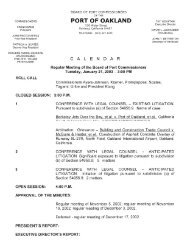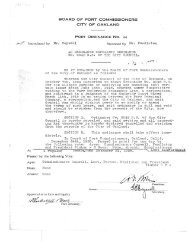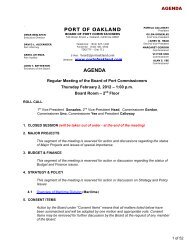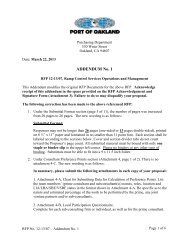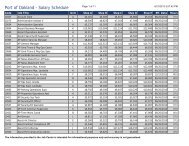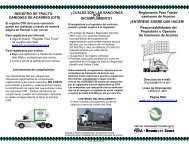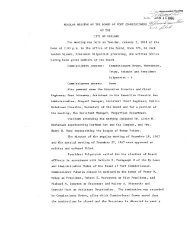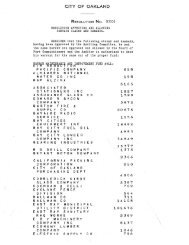Port-Wide Sewer System Management Plan(SSMP) - Port of Oakland
Port-Wide Sewer System Management Plan(SSMP) - Port of Oakland
Port-Wide Sewer System Management Plan(SSMP) - Port of Oakland
Create successful ePaper yourself
Turn your PDF publications into a flip-book with our unique Google optimized e-Paper software.
and redundancy in pumping capacity, and storage facilities. The CIP shall<br />
include an implementation schedule and shall identify sources <strong>of</strong> funding; and<br />
d. Schedule. The Enrollee shall develop a schedule <strong>of</strong> completion dates for all<br />
portions <strong>of</strong> the capital improvement program developed in (a) - (c) above. The<br />
schedule shall be reviewed and updated consistent with the <strong>SSMP</strong> review and<br />
update requirements as described in Section D.14 (<strong>of</strong> the GWDRs).<br />
9.2 SYSTEM EVALUATION AND CAPACITY ASSURANCE PLAN<br />
As part <strong>of</strong> this project, a <strong>Port</strong> specific SECAP has been developed, which is included in<br />
Appendix M for reference. The purpose <strong>of</strong> the SECAP is to identify capacity deficiencies in<br />
the wastewater collection system, develop feasible alternatives to correct these<br />
deficiencies, and plan the infrastructure that accommodate future wastewater flows. This<br />
section summarizes the major aspects <strong>of</strong> the SECAP as relevant to the specific GWDRs<br />
and RWQCB requirements.<br />
9.2.1 <strong>Plan</strong>ning Criteria<br />
Capacity analysis <strong>of</strong> the wastewater collection system was performed in accordance with<br />
the criteria established in the SECAP. This section summarizes the most important planning<br />
criteria that were used in the SECAP.<br />
9.2.1.1<br />
Gravity <strong>Sewer</strong>s<br />
<strong>Sewer</strong> pipe capacities are dependent on many factors, including roughness <strong>of</strong> the pipe, the<br />
maximum allowable depth <strong>of</strong> flow, minimum velocity, and slope <strong>of</strong> pipe. Relevant criteria<br />
are summarized below:<br />
• Manning Coefficient (n). The Manning coefficient 'n' is a friction coefficient and<br />
varies with respect to pipe material, size <strong>of</strong> pipe, depth <strong>of</strong> flow, smoothness <strong>of</strong> pipe<br />
and joints, and extent <strong>of</strong> root intrusion. For sewer pipes, the Manning coefficient<br />
typically ranges between 0.011 and 0.017, with 0.013 being a representative value<br />
used for sewer system planning.<br />
• Flow Depth Criteria (d/D). The primary criterion used to identify capacity deficient<br />
trunk sewers or to size new improvements is the maximum flow depth to pipe<br />
diameter ratio (d/D). The d/D value is defined as the depth (d) <strong>of</strong> flow in a pipe during<br />
peak flow conditions divided by the pipe’s diameter (D).<br />
– Flow Depth for Existing <strong>Sewer</strong>s. Using a conservative d/D ratio when<br />
evaluating existing sewers may lead to unnecessary replacement <strong>of</strong> existing<br />
pipelines. Therefore, a d/D ratio <strong>of</strong> 1.0 was used to evaluate the existing sewer<br />
system for peak wet weather flow (PWWF) (this is typically the maximum hourly<br />
flow in the collection system). If the flow depth was greater than the maximum<br />
allowed, then the sewer was deemed deficient and a larger sewer was<br />
proposed to provide greater flow capacity.<br />
May 2010 9-2<br />
pw://Carollo/Documents/Client/CA/<strong>Port</strong> <strong>of</strong> <strong>Oakland</strong>/8239A00/Deliverables/Ch09 (FinalA)



